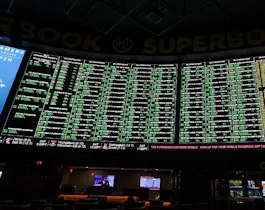Sports Betting & Gambling News for May 2024

California Tribes will Maintain Sports Betting Monopoly for Foreseeable Future
While legal sports betting in California seems years away at best, providers are acknowledging that if it comes to pass, the tribes of the Golden State will run the show.
by James Bisson

Ohtani's Former Interpreter, Ippei Mizuhara, Agrees to Plead Guilty to Bank, Tax Fraud
Ippei Mizuhara, the former interpreter for Shohei Ohtani, has agreed to plead guilty to one count of bank fraud and one count of tax fraud.
by Rob Paul

ESPN BET Lands PGA Championship Sponsorship Deal
The PGA Championship has become the first of the four major golf championships to land a title sponsor, and we have the details of the deal with ESPN BET.
by James Bisson

Fanatics Sportsbook and iCasino Launches in New Jersey
Fanatics Sportsbook has completed the transition from PointsBet in New Jersey, and we have the details about the newest game in the Garden State.
by James Bisson

NFL Draft Fan Survey: How Optimistic is Your Franchise's Fanbase in 2024?
When it comes to high hopes for this year's NFL Draft, no fanbase compares with the Chicago Bears – and no group of supporters is more jaded than the Carolina Panthers.
by Sportsbook Review

DraftKings Zeroing in on Texas?
While there are no imminent plans to establish a legal sports betting scene in Texas, DraftKings has recently made comments that indicate it's ready to go when the time comes.
by James Bisson

Adam Silver Says NBA Only Has 'So Much Control' Over Sports Betting Sites Offering Props
After recent news surrounding the possibility of the best sports betting sites banning prop bets in college sports, NBA commissioner Adam Silver addressed the likelihood of professional basketball following suit.
by Andrew Brennan

Virginia Sports Betting Handle Tops $600 Million Again
Virginia continues to roll along as a strong sports betting state, as evidenced by its recently released financials for March 2024.
by James Bisson

DraftKings Beats Expectations for Sports Betting Revenue in 2024 Q1 Earnings
The sportsbook reported a 53% year-over-year revenue growth to beat its first quarter expectations to open 2024.
by James Bisson

Bill to Ban Prop Bets on College Sports Officially Filed in North Carolina
North Carolina lawmakers have filed a bill to prohibit college player props, and it would end wagering on individual stats for college and amateur athletes.
by Rob Paul

Mississippi Fumbles Ball on Mobile Sports Betting For 2024
Despite legal sports betting at brick-and-mortar locations, Mississippi has failed to pass a bill allowing for a mobile sports betting platform.
by James Bisson

Tipico On the Cusp of Exiting U.S. Market
Tipico looks to be on the verge of exiting the U.S. market, but potential buyers are still interested in acquiring its American assets.
by James Bisson

NFL Draft Produces Surprises and a Few Major Payouts on Michael Penix Jr.
Some NFL bettors hit big on the Atlanta Falcons' selection of Michael Penix Jr. at number eight, and we have all the details.
by James Bisson

Mike Tyson vs. Jake Paul Officially Sanctioned as Pro Bout
Here are the details surrounding the pro bout designation that was recently applied to the Mike Tyson vs. Jake Paul boxing match scheduled for July 20, 2024.
by Andrew Reid

Colorado Enjoys Its 4th-Best Sports Betting Month Ever Thanks to March Madness
The Colorado Division of Gaming reported that March 2024 was its fourth-best month ever in 47 months of operation for the state's sports betting apps and retail providers.
by James Bisson

North Carolina Could Ban College Sports Prop Betting
North Carolina, America's newest legal sports betting jurisdiction, could soon alter its betting platform by removing college prop markets from its menu.
by James Bisson

Churchill Downs Sets Revenue Record in First Quarter
Churchill Downs, the racetrack that's home to the Kentucky Derby, has produced record first-quarter revenue to begin 2024.
by Sean Tomlinson

YouGov Report Shows Young Americans Prefer bet365 While Older Americans Like DraftKings
We have all the details of a recent YouGov survey of thousands of American sports bettors, with in-depth results.
by James Bisson

Caesars and NHL Enter into Blackjack Partnership
Looking into the details between Caesars Entertainment's partnership with the NHL, and the recently launched NHL Blackjack game.
by Andrew Reid

FanDuel Ramping Up Horse Racing Coverage Ahead of Kentucky Derby
FanDuel is set to increase horse racing coverage ahead of the Kentucky Derby, and we have all the details about its efforts.
by James Bisson

Jontay Porter Banned for Life from NBA Following Betting Investigation
Former Toronto Raptors and Toronto 905 forward Jontay Porter has been handed a lifetime ban from the NBA following an investigation into his betting violations.
by Rob Paul

New Jersey Has Fourth-Best Sports Betting Month Ever In March
New Jersey has reported its March sports betting financials, and things were largely positive for the Garden State. One shocking sportsbook had a particularly good month.
by James Bisson

Shohei Ohtani Betting Scandal Update: Ex-Interpreter to Plead Guilty
Shohei Ohtani's former interpreter is expected to plead guilty to bank fraud and illegal gambling charges, while the superstar appears to be in the clear.
by James Bisson

2024 Kentucky Derby Reports New Betting Handle Records
The 150th running of the Kentucky Derby in 2024 set a slew of new handle records for sportsbooks, and we examine the reasons why and what the new records are.
by Andrew Reid

AGA Study Reveals Sportsbook Advertising Spend Decline
Sportsbooks are spending a lot less on advertising with each passing year, and we have the details on the 2023 report from the American Gaming Association.
by James Bisson

Ohtani’s Former Interpreter Reportedly Paid off Bookie Through Resorts World
Shohei Ohtani's former interpreter, Ippei Mizuhara, reportedly stole more than $16 million from the Los Angeles Dodgers superstar to help settle $40.7 million in gambling debts.
by Andrew Brennan

Alabama Legal Sports Betting Not in the Cards in 2024
The House Bills have Alabama had developed to legalize sports betting didn't make it past the Senate, and it looks like a legal sports betting scene is not in the cards for 2024.
by James Bisson

Why Dave & Buster's is Offering Betting on Arcade Games
The dining and entertainment chain will soon allow customers to wager on arcade games in its latest foray into the betting scene.
by C Jackson Cowart

Who is the Next Women's Sports Mega-Star?
As the popularity of women's sports continues to surge world-wide, we ask the question: Who is positioned to become the next female sports superstar?
by James Bisson

Kentucky Derby Primed to Get More Sports Betting Attention in 2024
Sports betting was legalized in Kentucky not long ago, which should lead to more betting attention for the 2024 Kentucky Derby.
by Sean Tomlinson

Tough Month of March Reported for Nevada Sportsbooks
Nevada sportsbooks had a tough month in March, and now that the financials have been released we have you covered with all the details.
by James Bisson

ESPN BET Launches First-Ever Retail Sportsbook in Detroit
ESPN BET has launched its first brick-and-mortar retail sportsbook just in time for the NFL Draft, and we have all the details!
by James Bisson

Isaiah Rodgers Reinstated to NFL Following 2023 Gambling Suspension
Looking at the details surrounding the NFL's reinstatement of Philadelphia Eagles cornerback Isaiah Rodgers on Tuesday.
by Andrew Reid

Kindred Group Quarter 1 Earnings Report Released
Despite its upcoming exit from the North American market, Kindred Group's Q1 financials show growth in several areas.
by James Bisson

Kambi Q1 Revenues In Line With Expectations
While Kambi Group plc's Q1 report shows relatively flat numbers, it also shows that they are more or less in line with expectations.
by James Bisson

First Ever Chief Responsible Gaming Officer Hired By DraftKings
Lori Kalani has joined DraftKings as the company's first Chief Responsible Gaming Officer, and we have all the details on what the job encompasses.
by James Bisson

Missouri Hits 300,000 Signatures for Sports Betting Initiative
The Winning for Missouri Education campaign announced that 300,000 signatures have been gathered in support of a legalized sports betting platform.
by James Bisson

Mississippi Senate Votes To Keep Mobile Sports Betting Off The Table For Now
The Mississippi senate has voted against mobile sports betting for now.
by James Bisson

March Madness Proves Beneficial for Maryland Sportsbooks
March Madness was available to Maryland sports bettors for the first time in 2024, and the financials returned from their sportsbooks show that it was beneficial.
by James Bisson

Maryland Pushes on iCasino Legalization This Year
Despite having a legal sports betting scene, Maryland has failed again to capitalize on an opportunity to do the same for iCasinos.
by James Bisson

Fanatics Goes Live in Arizona
Fanatics has continued to make the changeover from PointsBet across the United States, and has officially launched in Arizona.
by James Bisson

Montana Bucks the Trend of Banning College Prop Bets
Montana has gone against the grain when it comes to banning college player props, and we have all the details about its decision to go that route.
by James Bisson
SBR's Betting & iGaming Journalists
Our expert writers, analysts and sportsbook reviewers have 100s of years experience between them in the sports betting and iGaming industries. Since 1999, SBR has been a trusted source of industry expertise and betting advice. We continue to be your trusted source for betting picks, news, up-to-date betting odds, and (of course) the best sportsbook and online casino reviews anywhere.
Regional Developments & Updates
Online sports betting can differ between regions. SBR offer the latest insights and scoop on developments and updates specific to your region below.
North Carolina sports betting is also launching on March 11, 2024 so keep an eye on expected North Carolina sports betting apps and North Carolina sportsbook promo codes.
U.S. States News
Keep informed about the state of online sports betting in these states:






